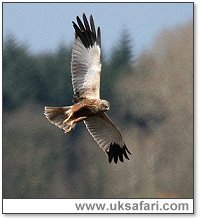
|

|
|
 Sent
to you Sent
to you
by e-mail
|
|
Simply
enter your details and hit the send button
more
info |
|


Click Here

Links
Advertise
Terms of Use
Contributors
About Us
Contact Us
|
 |
Go back
 | Bookmark
| Bookmark
 | Print Page
| Print Page  | E-Mail Us
| E-Mail Us 
 

Photo: Dean Eades |
|
Latin name: Circus aeruginosus
Size: Length around 50 - 55cm. Wingspan up to 140cm.
Distribution: Found in many areas of the UK. Breeds mainly in parts of eastern England, the Cambridgeshire Fens, Yorkshire, Lancashire, Kent and many parts of
Scotland.
Months seen: All year round. Some Marsh Harriers migrate to southern
Europe and Africa.
Habitat: Wetlands, reed beds, fens, marshes and nearby fields.
Food: Birds and small mammals.
Special features: The Marsh Harrier is slightly bigger than a buzzard,
but with slimmer body and wings. In the air the black wing tips are very
distinctive. The female is chocolate brown with a cream coloured head throat and
shoulders. The male has a greyish head and tail. The back of the wings are
grey in the middle and brown at the shoulders.
 In
springtime Marsh Harriers perform an elaborate aerial courtship display. The male
does a
dramatic inverted flight to pass food to the female. In
springtime Marsh Harriers perform an elaborate aerial courtship display. The male
does a
dramatic inverted flight to pass food to the female.
Persecution and drainage of the fens from the 1700's onwards caused a rapid
decline in the Marsh Harrier population. By the 1800's they were almost extinct
in the UK.
The use of pesticides in the 1950's added to their problems. The poisoned prey
they ate caused their egg shells to become extremely fragile, and by 1971 there
was just one pair of Marsh Hariers remaining at Minsmere RSPB reserve.

UK Safari Birds of Prey Section
UK Safari Birds Section
|
 |

|